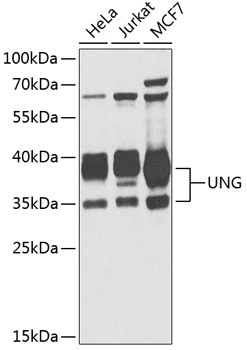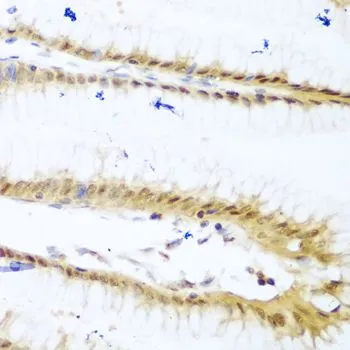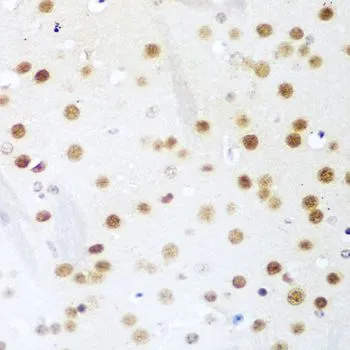
WB analysis of various sample lysates using GTX55836 UNG antibody. Dilution : 1:1000 Loading : 25microg per lane
UNG antibody
GTX55836
ApplicationsWestern Blot, ImmunoHistoChemistry, ImmunoHistoChemistry Paraffin
Product group Antibodies
ReactivityHuman, Mouse
TargetUNG
Overview
- SupplierGeneTex
- Product NameUNG antibody
- Delivery Days Customer9
- Application Supplier NoteWB: 1:1000 - 1:2000. IHC-P: 1:50 - 1:100. *Optimal dilutions/concentrations should be determined by the researcher.Not tested in other applications.
- ApplicationsWestern Blot, ImmunoHistoChemistry, ImmunoHistoChemistry Paraffin
- CertificationResearch Use Only
- ClonalityPolyclonal
- ConjugateUnconjugated
- Gene ID7374
- Target nameUNG
- Target descriptionuracil DNA glycosylase
- Target synonymsDGU; HIGM4; HIGM5; UDG; UNG1; UNG15; UNG2; uracil-DNA glycosylase; uracil-DNA glycosylase 1, uracil-DNA glycosylase 2
- HostRabbit
- IsotypeIgG
- Protein IDP13051
- Protein NameUracil-DNA glycosylase
- Scientific DescriptionThis gene encodes one of several uracil-DNA glycosylases. One important function of uracil-DNA glycosylases is to prevent mutagenesis by eliminating uracil from DNA molecules by cleaving the N-glycosylic bond and initiating the base-excision repair (BER) pathway. Uracil bases occur from cytosine deamination or misincorporation of dUMP residues. Alternative promoter usage and splicing of this gene leads to two different isoforms: the mitochondrial UNG1 and the nuclear UNG2. The UNG2 term was used as a previous symbol for the CCNO gene (GeneID 10309), which has been confused with this gene, in the literature and some databases. [provided by RefSeq, Nov 2010]
- ReactivityHuman, Mouse
- Storage Instruction-20°C or -80°C,2°C to 8°C
- UNSPSC12352203


